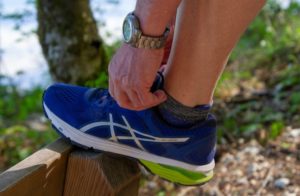Running is a wonderful form of exercise and as inexpensive as it is healthful. All a person needs is a good pair of running shoes, and some people have been known to run in their bare feet. However, like any athletic activity, doing it the wrong way can cause injury. Here are five injuries runners should be aware of:
Iliotibial Band Syndrome
The iliotibial band is a tendon that helps extend the knee and stabilize the leg when a person runs. When someone continually runs on an uneven surface or uses the wrong running technique, the tendon can become inflamed. The first sign is pain on the outside of the knee when walking downstairs, and the knee might be painful when the runner bends or straightens it. Fortunately, ITB syndrome responds well to rest and pain medication. The runner should be healed within two months.
Ankle Sprain
This injury also tends to happen when a person runs on uneven terrain. The ankle turns over and the bottom of the foot turns inward, which puts great stain on the ligaments on the outside of the ankle. The symptoms are stiffness, pain and swelling around the ankle. Ankle sprains respond well to rest, ice packs, compression and elevation, or the RICE procedure. Some people might need to use crutches till the injury heals.
Retrocalcaneal Bursitis
The retrocalcaneal bursae are fluid filled sacs at the back of the heel. They reduce the friction when the Achilles tendon passes over the heel bone. If the action is overdone, it causes the bursae to become inflamed. Retrocalcaneal bursitis can also happen if the runner wears the wrong type of shoe or runs incorrectly. The heel may be tender, red or swollen and the pain may worsen when the person stands on his or her tiptoes. This injury also responds well to the RICE procedure and should heal after about six weeks.
Tibialis Posterior Tendinopathy
This is caused when the tibialis posterior tendon is overused and becomes inflamed. Runners who overpronate, or roll their foot inward are especially subject to it. The symptoms are a gradually worsening pain at the back of the ankle and some swelling. If the injury is left untreated, the tendon may rupture and surgery will be needed. Fortunately, tibialis posterior tendinopathy responds well to the RICE treatment and over-the-counter pain medication.
Morton’s Neuroma
This is a compression of one of the plantar nerves found between the foot’s metatarsal bones. It happens when too much stress is put on the ball of the foot. The symptoms are burning, pain and numbness between the toes and cramps in the foot. Morton’s neuroma can also be alleviated by the RICE treatment and can be prevented in the future by wearing good running shoes.
Tricia is a mom and a blogger from Beverly Hills. She recommends Physiotherapy at Don Mills if you need to rehabilitate a running injury.




Leave a Reply